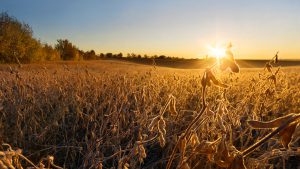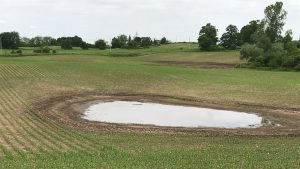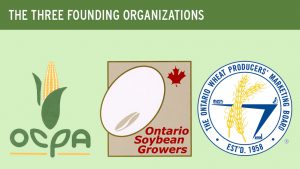Ten years of leadership
LOOKING BACK, MOVING FORWARD

| WHAT YOU NEED TO KNOW • Don Kenny was the first chair of the Grain Farmers of Ontario board following the amalgamation of the three legacy organizations: Ontario Corn Producers’ Association, Ontario Soybean Growers and the Ontario Wheat Producers’ Marketing Board. He served as chair from 2010 – 2011. • Henry Van Ankum stepped into the chair’s role in 2012. During his 3-year term, the organization increased their public communication and outreach efforts. • Mark Brock’s term as chair of the organization from 2015 – 2018 was dominated by the political and media attention of the neonicotinoid regulations. • Markus Haerle, the current chair of Grain Farmers of Ontario, is 2 years into his 3-year term, and he says that ongoing trade issues are the top-of-mind challenges he is dealing with. |
IN CELEBRATION OF Grain Farmers of Ontario’s ten-year milestone, Ontario Grain Farmer magazine sat down with the current and past chairs of the organization. Starting with the inaugural chair, Don Kenny, whose first order of business was to chart a new course for the organization, through to today’s chair, Markus Haerle, who reflects on the evolution of leadership and anticipated changes, all four chairs shared their highlights and experiences.
DON KENNY, CHAIR 2010 – 2011
Formerly the vice chair of the Ontario Corn Producers’ Association, one of Grain Farmers of Ontario’s’s legacy organizations, Kenny was elected by the inaugural board of directors as the first Grain Farmers of Ontario chair. “The first thing I told our new board was to throw away their old hats — this is a new organization and we are headed in a new direction,” says Kenny, who remembers the first board meeting well. “We had to remind ourselves that we can’t keep doing things the way they had been done before.”
A District 13 (Prince Edward, Lennox, Addington, Frontenac, Lanark, Leeds, Grenville, Renfrew, Ottawa) representative and farmer in Stittsville, Kenny knew he would have a challenging term, setting the first budget for the new organization, establishing committees and working with a new CEO, staff and directors. “I’m proud of the way we all came together.”
With all eyes on the new organization, Kenny knew government and the agricultural industry were paying close attention to the development of the new organization. “There was a lot of interest in Grain Farmers of Ontario, everyone was watching to see how we were going to make things work,” reflects Kenny. “And we did it. We pulled together and carried clout within industry and political circles, and quickly become recognized as provincial and national leaders in the grains and oilseeds industry.”
The amalgamation of the three legacy organizations — corn, soybean and wheat — was driven by the membership, and Kenny notes the tremendous support from Ontario grains and oilseeds farmers in those first few years as Grain Farmers of Ontario. “We were there to serve our members and I think they appreciated our efforts.”
The announcement of a fully funded Risk Management Plan (RMP) by the Ontario government in 2010 was the highlight of Kenny’s term as chair. The legacy organizations had been lobbying for the funding, making it a significant achievement in Grain Farmers of Ontario’s first year. He notes his disappointment when the RMP lasted only one year, and Grain Farmers of Ontario continues to lobby for the return of the fully funded program today.
Other highlights for Kenny include traveling across the province, meeting members, politicians and industry representatives. Kenny credits his term as his opportunity to meet agricultural leaders and mentors and is proud to have maintained many of those relationships. “And I was lucky to have worked alongside Barry Senft. It was clear from the start he was the right guy for the CEO job, bringing everyone together under one new organization and steering us
to success.”
The original term for the Grain Farmers of Ontario chair was set for two years under the Farm Products Marketing Commission. Kenny felt adding an extra year would enable the chair to accomplish more and benefit the organization. So, while Kenny served a two-year term, under his leadership the terms for the position were changed, extending the chair’s term to a three-year period.
“I’m proud of how far the organization has come in 10 years,” says Kenny. “Grain Farmers of Ontario’s achievements, respect and growth have met everything the membership wanted to see in a new organization.” Kenny has retired from the Grain Farmers of Ontario board and continues to farm in eastern Ontario.
HENRY VAN ANKUM, CHAIR 2012 – 2014
Currently a director for District 10 (Grey, Bruce, Wellington), Van Ankum, who farms near Alma, has been a Grain Farmers of Ontario director since the amalgamation of the legacy organizations and served a three-year term as chair from 2012 – 2014.
Like Kenny, Van Ankum focused his term on leaving the silos of the legacy organizations behind. “I tried to carry on where Don left off and continue to grow the culture of the new organization,” he says. Continuing with the momentum, Van Ankum focused on ramping up Grain Farmers of Ontario communications and outreach to members and the general public. “We launched the educational trailers, media campaigns, focused on public awareness and strengthened the organization in the process.”
Van Ankum’s first experience at a commodity board level was in 2005 when he joined the Ontario Wheat Producers’ Marketing Board. As a young director, he credits past chairs of the legacy organization for their encouragement and positive influence in helping him understand his role as director. “I continued to learn by watching other leaders, including Don in those first few years as a new organization,” he says. “I learned a lot through his approach to transition and bringing everyone on track as the new Grain Farmers of Ontario.” He continues to encourage Ontario farmers to get involved in their local districts and engage in industry concerns and issues.
Highlights of Van Ankum’s term as chair include working for members and towards common goals alongside staff and fellow directors, travelling Ontario and across the country to meet industry members and leaders, and gaining a better understanding and new appreciation for the diversity of the grains and oilseeds industry. “So many people were working for the betterment of Grain Farmers of Ontario and the overall industry, it was exciting to be a part of it,” says Van Ankum who also represented Ontario growers at an international level, participating in two meetings at the International Oilseed Producers Dialogue.
“Building strong industry and value chain collaborations at the national level is important for Grain Farmers of Ontario,” says Van Akum. As chair, he was able to play a role in the formation of Soy Canada and Cereals Canada. Both national organizations continue to serve growers and all sectors of the value chain at national and international levels, and Van Ankum is currently the vice chair of Cereals Canada.
Van Ankum notes an increase in the urban and rural divide during his term as chair. “There was a shift at the time, as the provincial government started taking a more environmentalist agenda,” he says. “We could feel pressure growing against some farming practices. It was and always will be our job to represent growers as best we can.”
MARK BROCK, CHAIR 2015 – 2017
“The regulations on neonicotinoids dominated my term as chair,” reflects Mark Brock. “But it’s the member support and teamwork as an organization that I remember during that time.” Brock notes that while Grain Farmers of Ontario and their members didn’t philosophically agree with the government’s approach or decision to regulate and ban the use of the insecticide, he is proud of how the organization handled the issue. “We found ourselves at odds with the government, but we approached every meeting in a respectful manner that represented the interests of Ontario grains and oilseeds farmers.” Brock reflects on some tough meetings and media interviews during that time, but says he could always count on moral support and acknowledgement from Grain Farmer of Ontario members.
“The professionalism shown during that tough time demonstrates how far our organization had grown and matured, enabling members, directors and staff to speak with one voice,” says Brock. Continued government and value chain relations at provincial and national levels were proving Grain Farmers of Ontario to be a highly respected organization in the grains and oilseeds industry. “We were increasingly sought after for opinions and leadership at a national level,” notes Brock. “Grain Farmers of Ontario had matured and was in the business of collaboration, and I’m proud of the relationships we developed with our national partners.” Continuing to lead the industry forward and follow membership direction, Grain Farmers of Ontario welcomed barley and oat growers to the organization in 2015.
Brock farms near Staffa and joined the inaugural Grain Farmers of Ontario board in 2010, where he was one of a few directors who hadn’t held director positions with the legacy organizations. He believes his fresh, unbiased approach to the board table was a benefit to him. “I had no previous experiences to draw from, making it an interesting learning experience in those early years,” he says. Brock says he was fortunate to have a number of mentors at the time, including Kenny and Van Ankum. He also credits his local District 9 (Perth) delegates for their support and encouragement. “I wouldn’t have joined as a delegate or a director if I wasn’t asked,” says Brock. “We all need a little encouragement and it’s important to reach out to young farmers especially, to support and encourage them to get involved.” He also credits CEO Barry Senft for his leadership and support to Brock during his term as chair and to the organization.
Believing in the importance of support and encouragement, Brock stepped off the board after serving as chair for three years. He is proud of the membership in his district and felt others should have the same opportunities he did to learn and benefit from volunteering with Grain Farmers of Ontario. “I definitely got out as much as I gave back to Grain Farmers of Ontario during my time on the board,” says Brock. “The opportunities provided and people I met fostered significant personal growth. And that’s one of the reasons I stepped back and encourage others to get involved.”
MARKUS HAERLE, CHAIR 2018-
Grain Farmers of Ontario’s current District 14 (Prescott, Russell, Stormont, Dundas, Glengarry) director and chair of the board, Markus Haerle farms near St. Isidore. Currently in his second year as chair, Haerle continues to focus his leadership role on collaboration and meeting membership expectations.
Trade issues and government elections have dominated Haerle’s term so far, challenging Grain Farmers of Ontario staff and directors to keep agriculture and issues affecting grains and oilseed farmers a priority for politicians. “It’s been frustrating, trying to engage government and help them understand the significance global trade negotiations are having on soybean farmers,” says Haerle. He acknowledges that the maturity of the organization has enabled Grain Farmers of Ontario to focus on issues impacting specific commodities, while continuing to support all commodities they represent. “Our directors address challenges that need attention, our focus isn’t determined on one commodity or the number of acres grown. For example, we’re also working hard to secure a viable Business Risk Management (BRM) tool for all Ontario grains and oilseeds producers.” Grain Farmers of Ontario has also been working closely with the provincial government to identify regulatory concerns and Haerle hopes to see some progress in reducing red tape for farm businesses.
Prior to joining the inaugural board in 2010, Haerle was a delegate with the corn and soybean legacy organizations. He’s seen Grain Farmers of Ontario’s evolution firsthand and is proud of the powerhouse the organization has grown into today. “We’re well respected at provincial, national and international levels as the voice for grains and oilseeds. Our industry position today is a direct result of our organization’s leadership — including our past chairs, board members, CEO and staff,” he says. “Other organizations look to Grain Farmers of Ontario as a positive example of how to amalgamate, come together to represent a common membership and speak with one voice.”
Participation in outgoing international trade missions has been a highlight of Haerle’s position so far. “The opportunity to see the strength of Canadian agriculture at an international level firsthand is exciting. Meeting leaders to discuss trade, market access, commodities and research confirms Canada is a leader and a player in our global marketplace,” he says. Haerle believes one of the most challenging parts of his job so far has been membership engagement. “It’s important to let our members know what we’re doing on their behalf, but sometimes matters move slowly and it’s a balance to keep members informed of our ongoing work.” Another challenge facing Haerle will be the upcoming retirement of CEO Barry Senft. “One of Grain Farmers of Ontario’s biggest tasks will be to continue the strength of our leadership momentum,” he says.
As the organization moves forward, Haerle expects a continued focus on strong leaders and leadership development for everyone within the organization will help maintain Grain Farmers of Ontario’s professionalism and respect within the industry. “I’m grateful for the past chairs and their diverse leadership styles. I believe everyone’s unique approach to bringing us together to sit at the same table and speak with one voice sets the stage for ongoing success.” •





















